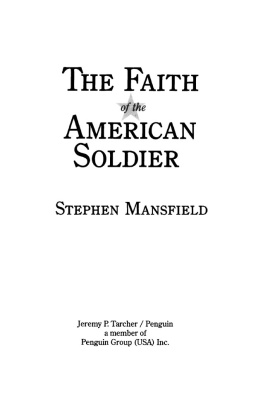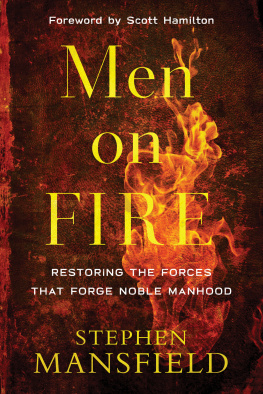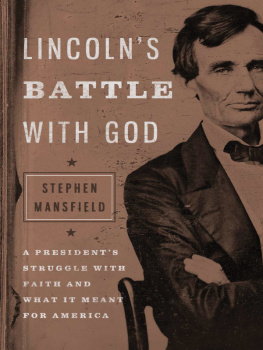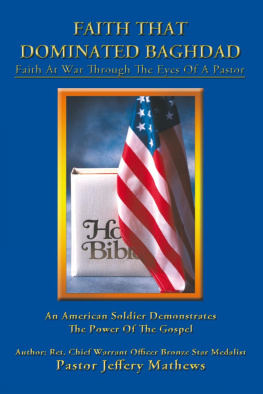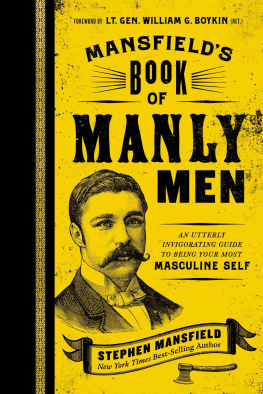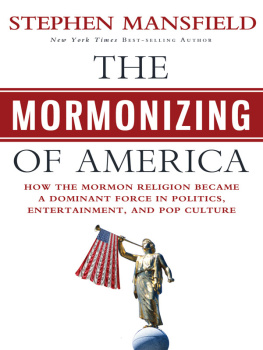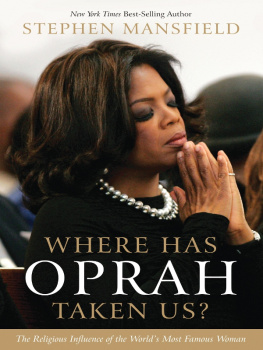T HE F AITH

A MERICAN
S OLDIER
T HE F AITH

A MERICAN
S OLDIER
S TEPHEN M ANSFIELD
Jeremy P. Tarcher / Penguin
a member of
Penguin Group (USA) Inc.
JEREMY P. TARCHER/PENGUIN
Published by the Penguin Group
Penguin Group (USA) Inc., 375 Hudson Street, New York, New York 10014, USA Penguin Group (Canada), 90 Eglinton Avenue East, Suite 700, Toronto, Ontario
M4P 2Y3, Canada (a division of Pearson Penguin Canada Inc.)
Penguin Books Ltd, 80 Strand, London WC2R 0RL, England
Penguin Ireland, 25 St Stephens Green, Dublin 2, Ireland
(a division of Penguin Books Ltd)
Penguin Group (Australia), 250 Camberwell Road, Camberwell,
Victoria 3124, Australia
(a division of Pearson Australia Group Pty Ltd)
Penguin Books India Pvt Ltd, 11 Community Centre, Panchsheel Park,
New Delhi110 017, India
Penguin Group (NZ), Cnr Airborne and Rosedale Roads, Albany, Auckland 1310,
New Zealand (a division of Pearson New Zealand Ltd)
Penguin Books (South Africa) (Pty) Ltd, 24 Sturdee Avenue, Rosebank,
Johannesburg 2196, South Africa
Penguin Books Ltd, Registered Offices: 80 Strand, London WC2R 0RL, England
First trade paperback edition 2006
Copyright 2005 by Stephen Mansfield
This book is being published jointly by Strang Communications and
Penguin Group (USA) Inc.
All rights reserved. No part of this book may be reproduced, scanned, or distributed in any printed or electronic form without permission. Please do not participate in or encourage piracy of copyed materials in violation of the authors rights.
Purchase only authorized editions.
Published simultaneously in Canada
Cover photo Scott Nelson/Getty Images
Cover design by Judith McKittrick
Author photo by Ben Pearson
Interior design by Terry Clifton
Most Tarcher/Penguin books are available at special quantity discounts for bulk purchase for sales promotions, premiums, fund-raising, and educational needs. Special books or book excerpts also can be created to fit specific needs. For details, write Penguin Group (USA) Inc. Special Markets, 375 Hudson Street, New York, NY 10014.
An application to register this book for cataloging has been
submitted to the Library of Congress.
ISBN 1-58542-407-2
EISBN 978-1-1015-6281-9
Printed in the United States of America
1 3 5 7 9 10 8 6 4 2
While the author has made every effort to provide accurate telephone numbers and Internet addresses at the time of publication, neither the publisher nor the author assumes any responsibility for errors, or for changes that occur after publication. Further, the publisher does not have any control over and does not assume any responsibility for author or third-party websites or their content.
A UTHORS N OTE
The author has, in most cases, witnessed the episodes recounted. In some instances, interviews with eyewitnesses have been used. Some of the individuals in this book are composites of real persons, and some names have been changed to protect an individuals privacy or security. To avoid confusion to the reader, when the unit of a soldier is mentioned, the name used for him is his own. When the unit is not mentioned, that name has been changed at the soldiers request.
TO THE CHAPLAINS,
HEROES OF FAITH
WHO TEND THE WARRIOR SOUL
A LSO BY S TEPHEN M ANSFIELD
Never Give In:
The Extraordinary Character of Winston Churchill
Faithful Volunteers:
The History of Religion in Tennessee
Then Darkness Fled:
The Liberating Wisdom of Booker T. Washington
More Than Dates and Dead People:
Recovering a Christian View of History
Forgotten Founding Father:
The Heroic Legacy of George Whitefield
The Faith of George W. Bush
Derek Prince: A Biography
P ROLOGUE
THE VIGIL AT ARMS
T here have always been rituals for welcoming men to the fellowship of arms. We read of them in Homer and Beowulf, in Cicero and the legends of King Arthur. Tacitus wrote of the Germans welcoming a young warrior to arms with the gift of a shield and a spear. Indeed, most every tribe and culture has had some ceremony that accompanied the belting of the sword.
By the latter Middle Ages, though, the heritage of these early traditions had merged with the liturgies and offices of the Christian church to fashion a new kind of warrior called the knight. He was intended to be the perfect merging of holy passion and military might, of spiritual devotion and martial skill. His calling was the defense of Christendom, a task he could only expect to fulfill with a pure heart and a holy life. His war, then, was as much to master himself as it was with the enemies of the realm. In fact, he believed he would never succeed in serving his king until he first succeeded in serving his God.
A man was never born to knighthood. It was something he had to prove himself to be. Knights were fashioned in battle, honed by mentors, and disciplined by hardship. Knights were molded in the holy fires of spiritual seeking. And when the time was right and a man was chosen for the call, he prepared himself for the moment of his ascendance with a ritual all knights underwent: the Vigil.
The Vigil was the final ceremony of cleansing, of meditation, and of sacrifice. It was a purifying and resolving of the hungers of the heart. It was the liturgy by which a man who was simply a warrior became a knight in the service of God.
The Vigil began early on the day before a man was to be knighted. He was first bathed, usually in rose water and usually in a wooden tub. This signified his baptism, his reenactment of the burial of Jesus Christ in the tomb, and His resurrection to life again. The knight-to-be understood from this that he was no longer his own, that his life had been bought by the death of the Lord he now followed. His sins were cleansed. His heart made new. His affections fixed to a new allegiance.
As a sign of shed vanity, the mans hair was usually cut. In the Middle Ages, the sacrificing of ones hair was seen as a sign of devotion to God. This meant that a knight often wore his hair in the same crudely cut manner as a monk, reminding him that he had entered a calling more than an army, a holy order more than just a soldiers life.
The knight candidate was then given new clothes. He first received a red garment with long sleeves and a hood that was placed over a white tunic. It was the symbol that this man was ready to shed his blood in the service of God and his king. Afterward a tight-fitting black coat was placed over the white and the red to signify that the knight should never fear death, which for the man of God is but reward.
Now properly cleansed and clothed, the man was taken to a chapel and left alone with his weapons and his armor. He had already begun a fast. It was a means of purifying both soul and body, humbling himself into his humanity, and reminding him always to champion the weak and the poor. Now, as a man clean in body and spirit, the knight-to-be presented himself to God.
With his companions and sponsors waiting prayerfully outside, the man spread his weapons on the altar and stood watch. For no less than ten hours, he prayed the prayers of devotion and ran his heart over each tool of his trade: his sword, his mace, his lance, his gauntlet, perhaps even his saddle and the standard of his king. And he waited. For God to receive him. For the words that would form his call. For the grace to conquer his passions. For the boldness befitting his charge.

